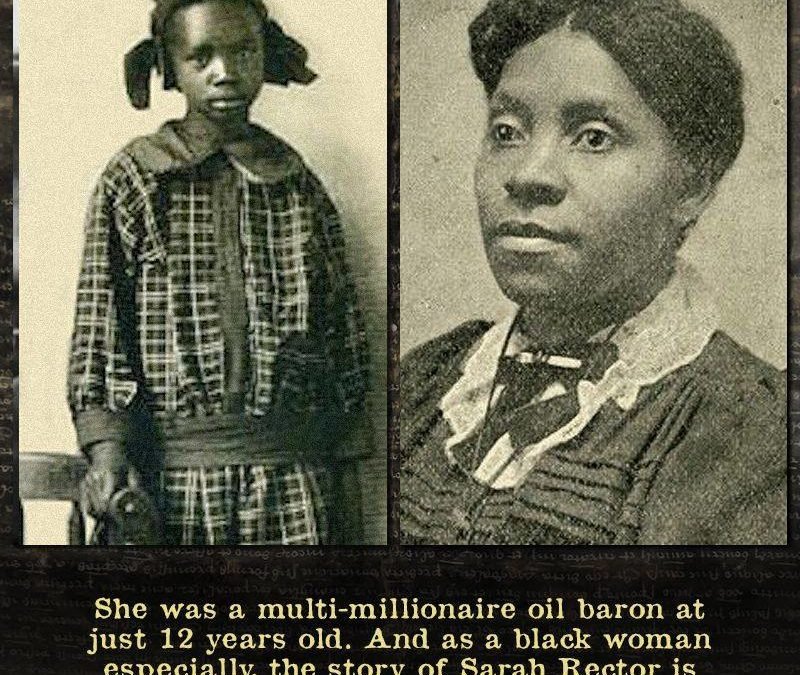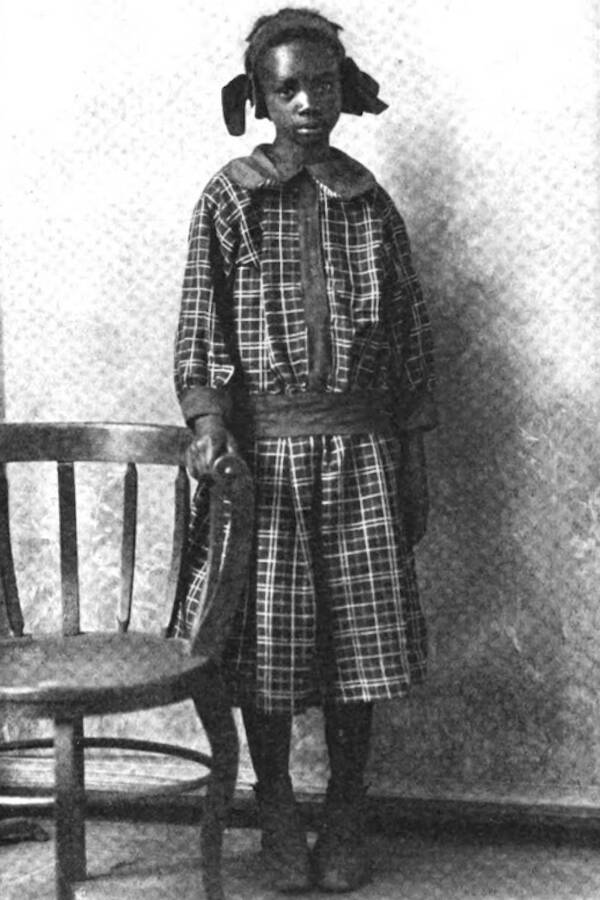Could you imagine being a millionaire before you even reached adulthood? For Sarah Rector, this wasn't a dream, but reality. Sarah Rector's ascent to becoming one of the first Black women millionaires in the United States is a story of unexpected fortune, deeply entwined with the complex history of race, land ownership, and the oil boom in early 20th-century Oklahoma.
Born on March 3, 1902, near Twine, Oklahoma, within the Muscogee Creek Nation territory, Sarah Rectors early life provided few hints of the extraordinary wealth that awaited her. Her parents, Joseph Rector and Rose McQueen, were descendants of Creek Indians and had both enslaved ancestry. Joseph and Rose's fathers both fought with the Union Army during the Civil War. The family's connection to the land was solidified when Oklahoma became a state in 1907. As part of the Dawes Allotment Act, designed to divide communal tribal land into individual holdings, Sarah and each member of her family received land allotments. This act, while ostensibly aimed at integrating Native Americans and their former slaves into American society, often led to exploitation and dispossession.
| Information | |
|---|---|
| Full Name | Sarah Rector Campbell Crawford |
| Birth Date | March 3, 1902 |
| Birth Place | Near Twine, Oklahoma, Muscogee Creek Nation territory |
| Death Date | June 22, 1967 |
| Parents | Joseph Rector and Rose McQueen |
| Ancestry | Creek Indian and African American (descendant of slaves) |
| Spouses | Kenneth Campbell (m. 1920), William Crawford (m. 1929) |
| Children | Clarence Campbell, Kenneth Campbell Jr. |
| Source of Wealth | Oil discovered on allotted land |
| Peak Net Worth | Estimated $1 million in the early 1920s (equivalent to approximately $14 million today) |
| Occupation | Landowner, entrepreneur |
| Legacy | One of the first African American women millionaires; symbol of early 20th-century Black wealth and resilience |
| Reference Link | Wikipedia - Sarah Rector |
The land allocated to Sarah, however, was initially deemed undesirable for farming. It was located some distance from her family's residence, and its perceived lack of agricultural value meant that the Rectors faced the burden of property taxes on land that appeared to offer no return. In 1913, when Sarah was just 11 years old, fate intervened in the form of a discovery that would forever alter her life and legacy: oil. An independent oil driller struck oil on her land, transforming the seemingly worthless plot into a geyser of black gold. Suddenly, Sarah Rector was not just a young girl in Oklahoma; she was a millionaire.
- Mary Travers Net Worth Untold Story Of A Folk Icons Fortune
- Lou Pearlman The Rise Fall Of A Boy Band Mogul
The discovery of oil on Sarahs land catapulted her into a world of unimaginable wealth. Royalties poured in, initially at a rate of $300 per day, which is approximately equivalent to $8,000 today. In October 1913 alone, she generated a staggering $11,567. When she turned 18, Sarah Rector's net worth was estimated at over $1 million, equivalent to about $28 million in today's dollars. This immense wealth included not only the oil royalties but also investments in stocks, bonds, businesses, and even a boarding house.
Rectors newfound wealth brought about a whirlwind of attention, both positive and negative. The Kansas City Star publicized her story with the headline "Millions to a Negro Girl," thrusting her into the international spotlight. While some celebrated her success, much of the coverage was tainted by racism and skepticism. The media, along with many white Americans, struggled to reconcile the image of a young Black girl with such extraordinary wealth. Her story became a source of fascination and, at times, exploitation.
As a minor, Sarah was assigned a white guardian to manage her affairs. Unfortunately, this was a common practice at the time, and it often led to the exploitation of wealthy Black children. While the intentions of her assigned guardians might have been initially honorable, the system itself was fraught with opportunities for corruption and mismanagement. Rector's family found themselves constantly battling legal and financial maneuvering, as various individuals and institutions sought to gain control of her fortune. This period of her life was marked by a cauldron of misinformation, public speculation, and legal battles as people tried to siphon off her wealth.
- Who Is Lewis Ranieri The Father Of Securitization Explained
- Boosie Badazz Net Worth What Is Boosie Worth 2024 Update
The immense wealth and fame profoundly impacted Sarah Rector's life. She received numerous marriage proposals and became a symbol of Black achievement and resilience. Despite the challenges and the constant scrutiny, Sarah was determined to use her wealth to improve her life and the lives of those around her. She was sent to the Children's Progressive Association Home in Kansas City for her education. Later, she studied at Tuskegee Institute in Alabama, further expanding her knowledge and preparing herself for the responsibilities that came with her wealth.
In 1920, Sarah married Kenneth Campbell and had three children: Clarence Campbell, Kenneth Campbell Jr., and a third child who died young. Her marriage to Campbell ended in divorce, and in 1929, she married William Crawford. She and Crawford remained together until her death. They lived a comfortable life, but her fortune was not immune to the economic downturn of the Great Depression. Sarah had inherited a fortune from oil land in 1913, but by the time she died in 1967, much of it was gone, impacted by mismanagement and the economic realities of the time.
Sarah Rector died in 1967 at the age of 65. While she may not have retained all of her wealth until the end of her life, her legacy as one of the first African American women millionaires remains significant. Her story highlights both the opportunities and challenges faced by Black Americans in the early 20th century. She was a symbol of what could be achieved with determination and a stroke of good fortune. Rector's story is a reminder of the complexities of American history and the enduring struggle for racial and economic equality.
Oklahoma historian George Wesley continues to conduct research on the life of Sarah Rector, who received hundreds of marriage proposals and was worth $11 million by the time she reached the peak of her wealth. Rectors notoriety ballooned just as quickly as her wealth. In the early 20th century, Sarah Rector was given 160 acres of land as part of a government treaty. According to Tonya Bolden, author of searching for Sarah Rector: The Richest Black Girl in America (Harry N. $21.95), Rector began earning more than $300 a day in 1913. She even generated $11,567 in October 1913.
Sarah Rector received international attention at the age of eleven when the Kansas City Star in 1913 publicized the headline, "Millions to a Negro Girl." From that moment Rectors life became a cauldron of misinformation, legal and financial maneuvering, and public speculation. Sarah Rector was a wealthy African American woman who gained notoriety for her immense wealth during the early 20th century. In 1902 Sarah Rector was born in the mostly Black town of Taft in the Oklahoma Territory, then regarded as Indian Territory.
Rectifying Sarah Rector, "The Richest Black Girl in America" and her family. Sarah Rector inherited a fortune from oil land in 1913. Sarah Rector was a descendant of slaves who inherited land that contained oil. She became a millionaire at 12 but faced racism and corruption from white guardians. Find out how she faced fame, fortune, and challenges in the early 20th century. Discover how her family was exploited by the media and the government and how they tried to protect their legacy.
Learn how Sarah Rector, a Creek Indian freedman, became the richest Black girl in America at 11 with an oil gusher on her land. Both Joseph and Rose had enslaved Creek ancestry, and both of their fathers fought with the Union Army during the Civil War. Sarah Rector, born in 1902, became one of the wealthiest African American women in the early 20th century. Her financial journey began when she was allotted a piece of land in Oklahoma as part of the Dawes Allotment Act. Then, in the fall of 1913, an independent driller struck liquid gold on Sarah Rectors land, bringing the family royalties of $300 per day, about $8,000 today.
Some estimates place Sarah Rectors net worth at the time at $1 million, or about $28 million today. One newspaper dubbed her "the richest Negro in the world." Understanding the net worth of individuals, especially those who have made a significant impact in history or culture, is a topic of great interest. Sarah Rector is a name that may not be widely known in the context of 2024, but her story is a fascinating one that intertwines with the history of wealth, race, and unexpected fortune in the early 20th century. Her net worth reached $14,000,000.
To understand Sarah Rectors net worth in 2024, one must consider the impact of inflation on historical wealth. The value of money changes over time, and this must be accounted for when estimating the current net worth. Another factor in estimating net worth is the potential growth of investments. Some Native Americans had owned slaves, and Sarahs family lived on Muscogee Creek Indian land. When Oklahoma became a state in 1907, the Dawes Allotment Act divided the land between the Creek Indians and their former slaves. Everyone in Sarahs family received land.
Sarah Rector was a descendant of slaves who inherited land that contained oil. She became a millionaire at 12 but faced racism and corruption from white guardians. Learn about the life of Sarah Rector, a young African American girl who became a millionaire overnight when oil was discovered on her land in 1913. Find out how she faced fame, fortune, and challenges in the early 20th century. Sarah Rector was born to Joseph and Rose Rector on March 3, 1902, near Twine, Oklahoma, on Muscogee Creek Native American Allotment land.
Learn the true story of Sarah Rector, a Creek freedman who became a millionaire from oil royalties in Oklahoma. Discover how her family was exploited by the media and the government and how they tried to protect their legacy. Sarah Rector was already a millionaire by the time she had turned 18. She owned stocks, bonds, a boarding house, businesses, and Sarah Rector was 11 years old in 1913 when oil was discovered on land she owned in Oklahoma. Her sudden wealth became the object of racist news coverage. At the age of 10, oil was discovered on her land, catapulting her into immense wealth overnight.

